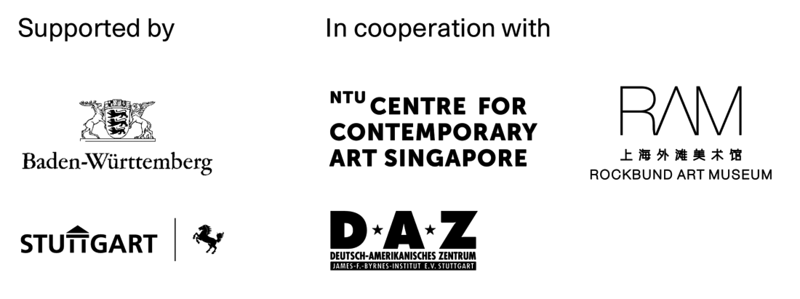The Ocean In A Drop
October 22, 2022–January 22, 2023
Entrance Stauffenbergstraße
Schlossplatz 2
70173 Stuttgart
Germany
Hours: Tuesday–Sunday 11am–6pm,
Wednesday 11am–8pm
T +49 711 223370
zentrale@wkv-stuttgart.de
An exhibition by: Württembergischer Kunstverein Stuttgart, in collaboration with NTU Centre for Contemporary Art Singapore and Rockbund Art Museum Shanghai.
Curators: Hans D. Christ, Iris Dressler
Trinh T. Minh-ha counts among the most important filmmakers worldwide. Since the early 1980s she has been developing a filmic, theoretical, and poetic oeuvre which is considered foundational for postcolonial and feminist approaches within art and research contexts.
With The Ocean In A Drop, running from October 22, 2022, to January 22, 2023, the Württembergischer Kunstverein Stuttgart is showing Germany’s first comprehensive solo exhibition by the Berkley-San Francisco-based artist, whose work includes musical compositions, poetry, and literature.
Trinh delves into the interstitial realms between documentation and fiction, theory and art, the visible and the audible. Her films, which have received various awards, have been mainly shot in different parts of Africa and Asia, presenting a multidimensional, polyphonic picture of the people living there, along with their cultures, living spaces, and political contexts. The title of the exhibition pays reference to the political and poetic forces found in her films, especially in aspects of the everyday that are unseen, unheroic and marginalized. Trinh’s films are intricate and yet, they remain simultaneously open in their narratives, interweaving a wealth of elements—music, language, and imagery, silence and vacuity, her own texts and those of others, or materials from various times and contexts—to create a multivocal and multilayered textured work. Here, the paradoxical, the unexpected, and the seemingly contradictory are the main keys offered by Trinh for arriving at a deeper understanding of the world. Moreover, in her work she has developed a practice of “speaking nearby” (Trinh, as differentiated from speaking “about,” “for” or “on top of”) which allows her to approach foreignness and otherness with intimacy and respect, thus thwarting the colonial gaze.
The Ocean In A Drop shows six long films from the 1980s to today, presented in six individual, color-coded rooms. Abstractly mirroring the individual works in the main exhibition space, which is framed by these film berths, are mini projections, citations, and also collages of film stills. Also, a selection of the artist’s books and related reference materials are presented on tables. The exhibition therefore plays out on two planes—equating to, yet also moving beyond, the cinema hall and the white cube.
Due to the visitors moving back and forth between the six berths, the concurrent projection of the films facilitates a somewhat fragmentary, rather than linear, perception of the individual pieces, along with a continual recombination of the fragments that carry within them the whole—the ocean within each drop. This gives rise to evernew relations between the individual films and the artist’s theoretical works.
Films in the exhibition
What About China?, USA, China 2021, digital film, 135 minutes
(with German subtitles)
Forgetting Vietnam, USA, Vietnam 2015, digital film, 90 minutes
Night Passage, USA 2004, digital film, 98 minutes
Shoot for the Contents, China, USA 1991, digital film (16mm), 102 minutes
Surname Viet Given Name Nam, USA 1989, digital film (16mm), 108 minutes
Naked Spaces – Living Is Round, USA 1985, digital film (16mm), 135 minutes
All films are in English.
About the artist
Trinh T. Minh-ha counts among the most important representatives of independent film worldwide. Since the early 1980s she has been developing a theoretical, filmic, and poetic oeuvre which is considered foundational for postcolonial and feminist approaches within art and research contexts, and which has significantly shifted the boundaries between documentation and fiction.
Born in Hanoi and raised in Saigon, Trinh emigrated to the United States in 1970 during the Vietnam War. After studying music composition, ethnomusicology and French literature in Illinois and Paris, she spent three years teaching at the National Conservatory of Music and Drama in Dakar, Senegal, starting in 1977. Her publications created together with the photographer and architect Jean-Paul Bourdier go back to this period, such as African Spaces: Designs for Living in Upper Volta (1985), as do her first two 16mm films, Reassemblage (1982) and Naked Spaces—Living Is Round (1985), both produced by Bourdier, who is involved in the organization of all of her filmic projects. From 1992 to 2022 Trinh taught at UC Berkeley in the departments of rhetoric and gender and women’s studies.
Among her most important theoretical-poetic writings are Women, Native, Other (1989), When the Moon Waxes Red (1991), Elsewhere, Within Here (2011), and Lovecidal: Walking with The Disappeared (2016), as well as compilations from interviews, and/or the film scripts in Framer Framed (1992) Cinema Interval (1999), The Digital Film Event (2005) and D-Passage. The Digital Way (2013).
Trinh has received numerous prizes and awards, such as the Wild Dreamer Lifetime Achievement Award of the Subversive Festival 2014 in Zagreb, the Trailblazers Award of the Cannes International Documentary Film Event 2006, and the Best Cinematography Award of the Sundance Film Festival 1992 for the film Shoot for the Contents. Her most recent film, What About China?, was the 2022 recipient of the New Vision: CPH Dox Award, the Prix Bartók of the Jean Rouch Film festival and the prestigious Persistence of Vision Award of the San Francisco International Film Festival.


